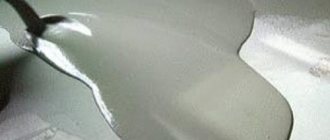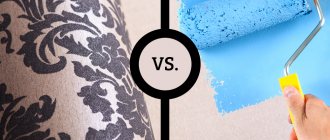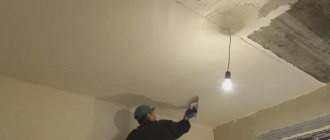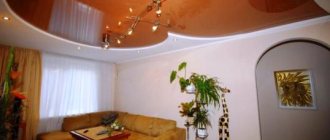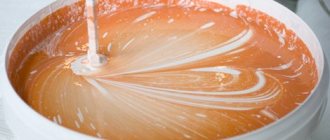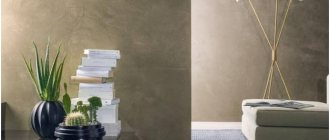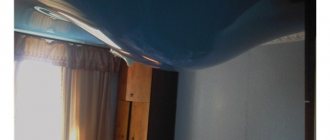What criteria should you use to choose paint?
First of all, you should determine the following points for yourself:
- how much money are you willing to pay for paint;
- whether it will be necessary to do wet cleaning of the ceiling in the future, and also in what room it will be located - dry or wet;
- whether it is necessary to eliminate defects on the surface for painting or whether it is sufficiently smooth;
- design approach (whether visual expansion of space is required using a certain color or surface texture);
- whether the room has certain negative factors for the ceiling (for example, if it is a kitchen).
If you analyze these parameters, it will be easier for you to decide on a specific option among the many paints offered.
Water-based ceiling paint comes in the following types:
- matte;
- glossy;
- semi-gloss;
- textured.
Based on their properties, paints are divided into waterproof and regular. The former can be used in bathrooms and kitchens, since the bathroom is characterized by its constant excessive humidity, and the kitchen needs frequent wet cleaning of the ceiling, because soot and droplets of fat quickly accumulate on its surface.
Useful tips
During the renovation process, all sorts of questions arise in our heads all the time. We will try to answer some of them.
Which water-based paint is best for the ceiling?
There are quite a few brands of water-based emulsion; these are: Sniezka, Feidal, Eskaro Relief, Eskaro Titan Lux 7. They all have common characteristics. The best are Feidal and Eskaro Titan Lux 7.
- The Feidal Antischimmel Weiss brand is designed specifically for rooms where there is a very high degree of humidity. It is successfully used to paint walls and ceilings in bakeries, breweries, kitchens, laundries and meat shops. Its consumption is low: from 0.13 to 0.2 liters per square meter. Plus, it is resistant to mold and mildew.
- Eskaro Titan Lux 7 brand is intended for walls and ceilings with various applications. This paint can be used to cover dissimilar surfaces (brick, chipboard, fiberboard, concrete, aerated concrete, plasterboard).
Which paint is better for the ceiling, acrylic or latex?
The type of paint directly depends on the purpose of the room.
- Latex paint is perfect for frequently ventilated rooms with high humidity levels. In addition, if the surface you plan to paint has cracks up to 1 mm or you want to cover wallpaper, you need this type of paint and varnish material.
- Acrylic paint is well suited for rooms with a high degree of exposure to ultraviolet rays, as well as surfaces covered with cracks of 5 mm or more.
What paint is best for the ceiling in the kitchen?
The kitchen is a place where, in the absence of a hood, there is high humidity or risk of contamination, so the ideal option is silicone, which eliminates the possibility of the development of fungus or mold. Its disadvantage is its high cost. What is the most affordable way to paint the ceiling in the kitchen? Choose the water-based brand Feidal Antischimmel Weiss.
We offer you video tips from professionals:
What paint is better to use
On sale you can find water-based and water-dispersion paints. Their properties differ in that the first option is afraid of moisture, that is, such ceilings cannot be washed. The second option will not lose its appearance after wet cleaning. There are also oil paints, but they leave a dense layer on the ceiling that does not allow air to pass through, which can contribute to future damage to the surface.
Water-based paints do not have this drawback. Such mixtures are fireproof, environmentally friendly and practically odorless. Once applied, the paint dries very quickly (about 2 hours), it is very easy to work with, and once applied it lasts a very long time. It is worth noting that water-based white ceiling paint can be painted in any shade, while the predominant color on sale is white.
The client can easily choose the right shade for himself directly in the store, thus solving any design problem.
A few words about modern paints
To make the choice easier, manufacturers began to produce special ceiling materials that are resistant to negative factors. For example, rising vapors.
Basically, ceiling paints are dispersed solutions based on synthetic adhesives. They are usually white, and to create a color tint, they add pigment - color, which is mixed just before application.
Modern ceiling materials are divided by consumers into 3 types, differing in moisture resistance and abrasion. This division is not fundamental, but it is what is most often oriented towards when choosing:
- Whitewashing - it is clear that such a surface cannot be washed or cleaned.
- Painting that can be washed with soapy water.
- A surface finish that can not only be washed, but also cleaned with brushes.
This is not a professional division, but it is how consumers choose the best paint. Although it should be noted that the moisture resistance indicator is determined by the quantitative content of biological and synthetic components in the material - pigments, thickeners, inhibitors, biocides and others.
But designers divide ceiling paints according to the degree of gloss into glossy and matte. Both options are used with great success for finishing ceiling surfaces. At the same time, matte analogues do not glare like glossy ones. In addition, with their help you can level ceilings and repair small defects and flaws.
Properties of different types of ceiling paint
Silicate paints
– a mixture of several components in a solution of alkali metal silicates. They have good vapor and air permeability, are not afraid of ultraviolet radiation and fire, and are environmentally friendly. Dirt sticks to painted surfaces less easily, plus silicate mixtures are inexpensive. The disadvantages include the lack of water resistance and abrasion resistance. When working with such mixtures, it is worth keeping in mind that after a day an insoluble precipitate appears in them, after which it will be impossible to use them.
When deciding which paint is best to choose for the ceiling, you can pay attention to their mineral varieties. The pigment in such mixtures is crushed minerals. From the name we can conclude that this is an environmentally friendly material. The advantages of paint include its breathability, so the surface after application does not become moisturized and does not deteriorate. Considering the technical qualities, one can note their hiding power, plasticity and hydrophobicity. The only drawback of such paints is that the painted surface cannot be cleaned either dry or wet. If we talk about cost, then such material is considered the most acceptable.
Polyvinyl acetate enamels
– mixtures based on PVA. As a result, we have a glossy surface, but the layer becomes dense and flexible, and wet cleaning cannot be carried out. When interacting with water, stains form on the surface, which is why it is more advisable to use them on ceilings in the living room.
Acrylic paint
— acrylic resins are used as a pigment. Such mixtures are more expensive than the previous ones, but due to their properties they can be used for almost any surface. The painted ceiling is not afraid of mechanical stress and moisture, which makes subsequent wet cleaning possible. After painting with acrylic paint, the surface will be matte.
Latex based paints
. They operate according to the following principle: being in a closed container and in a liquid state, the particles do not interact with each other and do not solidify. After applying a layer of paint to the surface, the water from the mixture evaporates, after which the latex particles begin to interact with each other and adhere tightly to the surface, forming a kind of continuous film. Latex paints are ideal for surfaces that require high protection against abrasion and moisture. The treated surface does not attract dust and dirt. The buyer has a choice of matte and glossy compositions with different degrees of gloss. To determine how matte or glossy the ceiling will end up, you need to take into account the number indicating this parameter. The higher it is, the higher the gloss level. The cost of latex paints is slightly higher than previous varieties, but due to their durability and wear resistance, they are worth it.
Silicone paint
for the ceiling is distinguished by inclusions of silicone resins. In terms of their qualities, such compositions are somewhat similar to latex paints, with the only difference being that they have even greater protection against abrasion. Such paints will be an excellent choice for painting kitchen ceilings - there is no need to be afraid of doing wet cleaning, and also clean the surface with a brush if necessary. The price of the mixtures is compensated by the durability of the material. Silicone and latex paints can be used to coat textured wallpaper, drywall and plaster. They come in matte and glossy.
Types of water-based paints
Polyvinyl acetate
| pros | Minuses |
| The cheapest option, environmentally friendly. Resistant to fats and oils. | The paint is sensitive to moisture and washes off quickly. |
Acrylic
Acrylic water-based paint
| pros | Minuses |
| Variety of colors, washable, excellent water-repellent properties. The paint is frost-resistant, protects against corrosion, is vapor-permeable, and resistant to UV rays. | Not high gas permeability. |
Latex
Latex water-based paint
| pros | Minuses |
| They hide cracks well, have water-repellent properties, and can be washed. They have a two-layer application. | Quite expensive paints. The paint is subject to fading. |
Silicate
| pros | Minuses |
| The paint is durable, vapor-permeable, and resistant to temperature changes. | Contains alkali, limited in color palette. |
Silicone
Silicone water-based paint
| pros | Minuses |
| The paint is vapor-permeable, hides cracks, and is antimicrobial. Not afraid of water, elastic, resistant to stains. | High price |
For information on how best to choose paint colors, watch the video below.
Types of additives
When deciding which ceiling paint is best, you should pay attention to some nuances when choosing it. If you decide to paint the ceiling in the bathroom, then it would be a good idea to buy a mixture with fungicidal additives to prevent the formation of mold. Paint manufacturers often add all kinds of antiseptics to them to prevent the development of microorganisms. Thixotropic properties will allow the mixture to lie more evenly on the surface. In order for the ceiling surface to acquire decorative properties, you can purchase paints with texture additives. They are a fine powder, due to which the surface becomes rough visually and to the touch. There are paints with matting additives, but such impurities make the mixture not so resistant to abrasion.
Division by basis
Paints are divided into several groups according to the material from which they are made
Ceiling paints are divided into several groups according to the material from which they are made. Today the best ceiling paints are:
- Water-based.
- Acrylic.
- Silicone.
- Latex.
- Silicate.
What are the features of each type?
Water-based materials
Water-based paint "Ekodom" is intended for painting ceilings
This is the most common ceiling covering, which guarantees an excellent quality finish.
In addition, the material:
- non-toxic
- does not emit harmful impurities, which increases its environmental friendliness
- has no smell
- easy to apply
- suitable for painting any surfaces except those painted with glossy paint
- washes well with warm soapy water
- allows you to apply any paint on top
Acrylic material
Universal paint
It belongs to the “universal” category, which is why it is especially popular today.
A wide range of advantages has made acrylic paints the most popular. Their advantages should be emphasized:
- moisture resistance
- wear resistance
- practicality - you can wash and clean the ceiling painted with acrylic paint with any detergents
- the material perfectly retains its original color - the only thing is that after drying it darkens a little
- practically does not change color under the influence of ultraviolet rays
The process of applying acrylic paint to the ceiling is quite simple. In addition, it copes with minor defects of the ceiling surface, dries quickly and lasts a very long time. And besides white, you can choose a huge palette of other shades.
Latex paint
This material boasts the highest levels of moisture resistance and abrasion resistance. This ceiling can be washed as much as you like, and its coating will look the same as in the original version.
This is a good paint that can be used to cover cracks no larger than 1 millimeter. And although this is a dense material, it allows air to pass through well. So the ceiling underneath “breathes”.
Silicate materials
This paint contains up to 10% alkali
They are made on the basis of liquid glass, so they belong to the “mineral” group. They are usually used for ceilings with a concrete or plastered surface.
This paint does not interact with polymers. Therefore, you will definitely have difficulties if you decide to repaint the ceiling after silicate paint has been applied to its surface. It will have to be torn off, completely clearing the ceiling.
The elasticity of the material leaves much to be desired, so it does not cover minor defects.
This paint contains up to 10% alkali, and this requires taking precautions when working with it. In addition, alkali limits the color palette, which does not please potential consumers.
But it has one big advantage - it is practically an antiseptic solution, so the likelihood that microorganisms will never multiply on the ceiling is very high.
Silicone paints
Assortment of rollers
This is the latest generation of finishing materials. They combine all the advantages of both mineral and organic species.
And all because silicone resin is used as a base. And it not only ensures durable operation, but also combines the positive qualities of this material.
The only negative is the high price. Therefore, anyone who decides to use silicone paints in ceiling repairs will emphasize the prestige of their home.
Consumption
For many buyers, the factor that determines which ceiling paint is best will be its consumption. Usually the manufacturer indicates this information on the can. However, it is also worth considering the fact that different surfaces absorb paint differently, and therefore the consumption will differ. For example, painted wallpaper or plaster will require approximately 15% more paint. To better understand how much emulsion you will need, you can use the corresponding tables.
A win-win
For example, interior paint from Marshall meets all the specified criteria: it costs about 500 rubles. for 1 liter (consumption – 9 sq. m., 2 liters are enough to finish the ceiling of a standard size bedroom). You can also decorate the walls with the same paint. Wet cleaning is not prohibited.
If you still find it difficult to choose paint yourself, but do not want to make a mistake, give preference to well-known brands, for example, Marshall or Tikkurila.
Painting a ceiling is a simple and quick way to make repairs and restore its surface, in contrast to the previously popular labor-intensive method of whitewashing. Modern water-based paints are ideal for this purpose, with granules that bind together, burst when the liquid evaporates from the surface and “spread” evenly across the ceiling. This is just an amateur's dream and a godsend for a professional. She pushed into the background all types of paints known so far.
But manufacturers (both domestic and foreign) did not stop at the achieved result. Representatives of the “water emulsion” of different compositions made it possible to satisfy the needs in the most severe cases, such as ceilings in the bathroom suffering from fungus, and in the kitchen from soot. And among all today’s diversity, it would seem that you can get confused, but if you know what exactly you need, you can safely calculate the consumption and cost of the necessary material.
In your choice, take into account the features of the room in which you will be finishing the ceiling and the material of the ceiling itself. Be aware of the criteria that other buyers and market leaders are looking for. Then you won’t go wrong with your purchase and will be able to advise others on what paint to choose for the ceiling. Happy shopping!
Surfaces and rules for painting them
It is very easy to paint with water-based paint. However, there are a number of rules that should be used when working, taking into account the fact that different surfaces affect the consumption of material and its choice. It is important to properly prepare the surface for painting; this will reduce paint consumption.
Some tips for painting surfaces:
- Water-based emulsion is usually used for painting smooth surfaces. If you choose to coat plaster that may have rough edges, you will end up wasting paint. It is better to pay attention to mixtures with high covering qualities.
- The viscosity of the paint must also be taken into account. This indicator indicates the ratio according to which the mixture can be diluted with water. Many specialists dilute the water-based emulsion right before starting work so that the layer is applied more thinly. However, this cannot be done if the paint has low viscosity - you will need to apply an additional layer.
- It is best to carry out painting work during the day in sufficient light. You will be able to see all the flaws and, if necessary, correct everything in time. This is especially important if the paint is white or light shades; under artificial lighting, the ceiling coating may not be of such high quality.
What paint to choose for the ceiling and walls: nuances
- When painting the ceiling and walls in a residential area, you should choose paints that are safe for human health;
- Compositions should be chosen that are quick-drying and do not create unpleasant strong odors;
- The paint should be easy to apply and not require the use of professional skills or specialized equipment;
This point is important if you plan to paint the ceiling and walls yourself!
- Materials for painting walls should be more wear-resistant and have the ability to retain their original color longer than ceiling paints;
This is due to the fact that the surface of the walls is more often exposed to external influences. Furniture may come into contact with the walls and various contaminants may get in, especially if it is a kitchen or a children's room. Also, the presence of pets can have a detrimental effect on the condition of painted walls.
- When choosing paint for walls, the hiding power is of particular importance - this is the minimum amount of paint composition that may be required to evenly paint over the original color.
It is the value of this indicator that determines the paint consumption and its efficiency.
- To calculate the required amount of paint for the ceiling or walls, you need to take measurements of the room and calculate its area.
When calculating, it is not recommended to subtract the area of windows and doors, since it is always better to have some supply of paint. If there is a shortage of paint, its tone will have to be selected again and there is a possibility that in the end it will still differ from the original one. And don't forget to take into account the number of coats of paint you plan to apply, i.e. what saturation and density do you want to achieve as a result? This will also affect paint consumption.
- Humidity indicator is another important aspect in choosing paint. If you plan to paint the bathroom, then you need to choose moisture-resistant compounds that protect against the formation of mold.
It is worth paying attention to the same point when painting the walls of kitchen premises.
- Only hypoallergenic and environmentally friendly substances are used to paint the surfaces of ceilings and walls in children's rooms.
